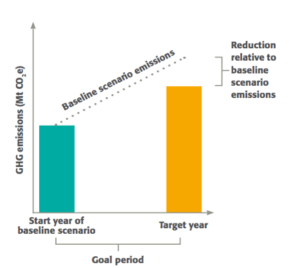To determine changes in greenhouse gas (GHG) emissions resulting from a mitigation intervention project, a reference point is necessary. Two types of reference points are possible: a base year or a baseline.
The use and calculation of baseline or base year emissions depend on the nature and objective of the intended mitigation calculation.
Mitigation goal types
- Reduce, or control the increase of, emissions by a specified quantity relative to a base year. For example, a 15% emission reduction from 2000 levels by 2030.
- Reduce emissions intensity (emissions per unit of another variable, typically GDP) by a specified quantity relative to a base year. For example, a 55% reduction from 2010 base year intensity by 2050.
- Reduce emissions by a specified quantity relative to a projected emissions baseline scenario. A baseline scenario is a reference case that represents future events or conditions most likely to occur in the absence of activities taken to meet the mitigation goal. For example, a 30% reduction from baseline scenario emissions in 2020.


Base year Baseline
Base year
A base year is a year in the past against which current emissions are compared. The base year usually corresponds to the start of an intervention or policy. A base year is best to assess emission reductions toward climate change goals. Cumulative changes can be assessed over periods of time and compared against other projects with the same base year. If a time series for determining a base year has been estimated but there are gaps for data in some years, the following methods can be used:
- Interpolation: in some cases, it may be possible to apply a method intermittently throughout the time series. For example, necessary statistics may only be collected every few years, or it may be impractical to conduct surveys on an annual basis. In this case, interpolating between estimates can develop estimates for the intermediate years of the time series. If information about the general trends or underlying parameters is available, then the surrogate data method is preferable.
- Extrapolation: when estimates have not been prepared for the base year or the most recent year in the inventory, it may be necessary to extrapolate from the closest detailed estimates. Extrapolation is similar to interpolation, but less is known about the actual trend. Extrapolation can be conducted either forward (to estimate more recent emissions or removals) or backward (to estimate a base year), assuming that the trend of observed estimates remains constant over the period of extrapolation.
- Surrogate data: the surrogate method relates emissions or removals to underlying activity or other indicative data. Changes in these data are used to simulate the trend in emissions or removals. The estimate should be related to the statistical data source that best explains the time variations of the category.
Estimating base year emissions (for users with base year emissions goals or base year intensity goals)
Steps to calculate base year emissions are:
- Estimate base year emissions by calculating (net) emissions of the project. (See IPCC Guidelines Vol 1 Ch5)
- For those using base year intensity goals: calculate base year emissions intensity. To do this, users should divide base year emissions by the level of output in the base year (e.g., emissions associated with milk production divided by the milk produced, base year emissions intensity=tonsCO2e / tons of milk produced).
Baseline
Also known as a business-as-usual (BAU) scenario or a projection, a baseline is a reference point that reflects the hypothetical emissions expected to occur without intervention. A baseline reference is appropriate for assessing improvements in emission efficiency or changes at a single point in time. It can also be used where base year data are not available.
Estimating baseline scenario emissions (for users with baseline scenario goals)
A baseline scenario is a reference scenario representing future events or conditions most likely to occur in the absence of a given project or policy activities taken to meet the mitigation goal. Developing a baseline scenario may need to consider a series of factors that drive emissions and assumptions on how these factors are expected to change over time as a function of policies and actions.
